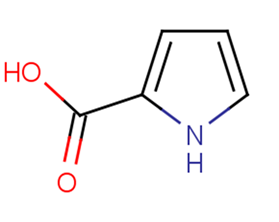Pyrrole-2-carboxylic acid
| Code | Size | Price |
|---|
| TAR-T4716-500mg | 500mg | £103.00 | |||||||||||||||||||||||||||||||||||||||||||||||||||||||||||||||||||||||||||||||||||||||||||||||||
| Special offer! Add £1 to your order to get a TargetMol CCK-8 Kit. Read more here. | |||||||||||||||||||||||||||||||||||||||||||||||||||||||||||||||||||||||||||||||||||||||||||||||||||
Quantity:
| TAR-T4716-1mL | 1 mL * 10 mM (in DMSO) | £107.00 | |||||||||||||||||||||||||||||||||||||||||||||||||||||||||||||||||||||||||||||||||||||||||||||||||
| Special offer! Add £1 to your order to get a TargetMol CCK-8 Kit. Read more here. | |||||||||||||||||||||||||||||||||||||||||||||||||||||||||||||||||||||||||||||||||||||||||||||||||||
Quantity:
| TAR-T4716-1g | 1g | £109.00 | |||||||||||||||||||||||||||||||||||||||||||||||||||||||||||||||||||||||||||||||||||||||||||||||||
| Special offer! Add £1 to your order to get a TargetMol CCK-8 Kit. Read more here. | |||||||||||||||||||||||||||||||||||||||||||||||||||||||||||||||||||||||||||||||||||||||||||||||||||
Quantity:
Prices exclude any Taxes / VAT
Overview
Regulatory Status: RUO
Shipping:
cool pack
Storage:
-20℃
Images
Documents
Further Information
Bioactivity:
Pyrrole-2-carboxylic acid was first identified as a degradation product of sialic acids, then as a derivative of the oxidation of the D-hydroxyproline isomers by mammalian D-amino acid oxidase. The latter relationship results from the lability of the direct oxidation product, A'-pyrroline-4-hydroxy-2-carboxylic acid, which loses water spontaneously to form the pyrrole. A similar reaction is catalyzed by the more specific allohydroxy-D-proline oxidase of Pseudomonas. In whole animal observations, pyrrole-2-carboxylate (PCA) ' was identified in rat or human urine after administration of the D-isomers of hydroxyproline, a finding ascribable to the action of D-amino acid oxidase. Urinary excretion of N-(pyrrole-2-carboxyl) glycine has been reported in a 5-year-old affected with type II hyperprolinemia; The child has mild developmental delay, recurrent seizures of the grand mal type and EEG alterations.
CAS:
634-97-9
Formula:
C5H5NO2
Molecular Weight:
111.1
Pathway:
Metabolism
Purity:
0.9995
SMILES:
OC(=O)c1ccc[nH]1
Target:
Endogenous Metabolite
References
He XX, et al. Pelopuradazole, a new imidazole derivative alkaloid from the marine bacteria Pelomonas puraquae sp. nov. Nat Prod Res. 2014;28(9):680-2.



